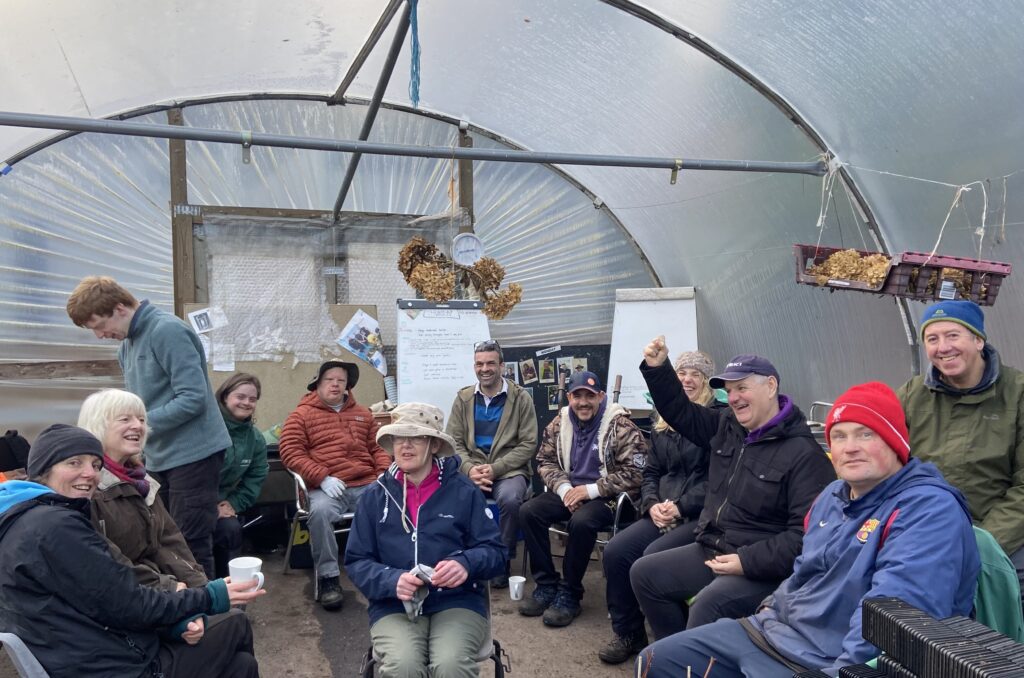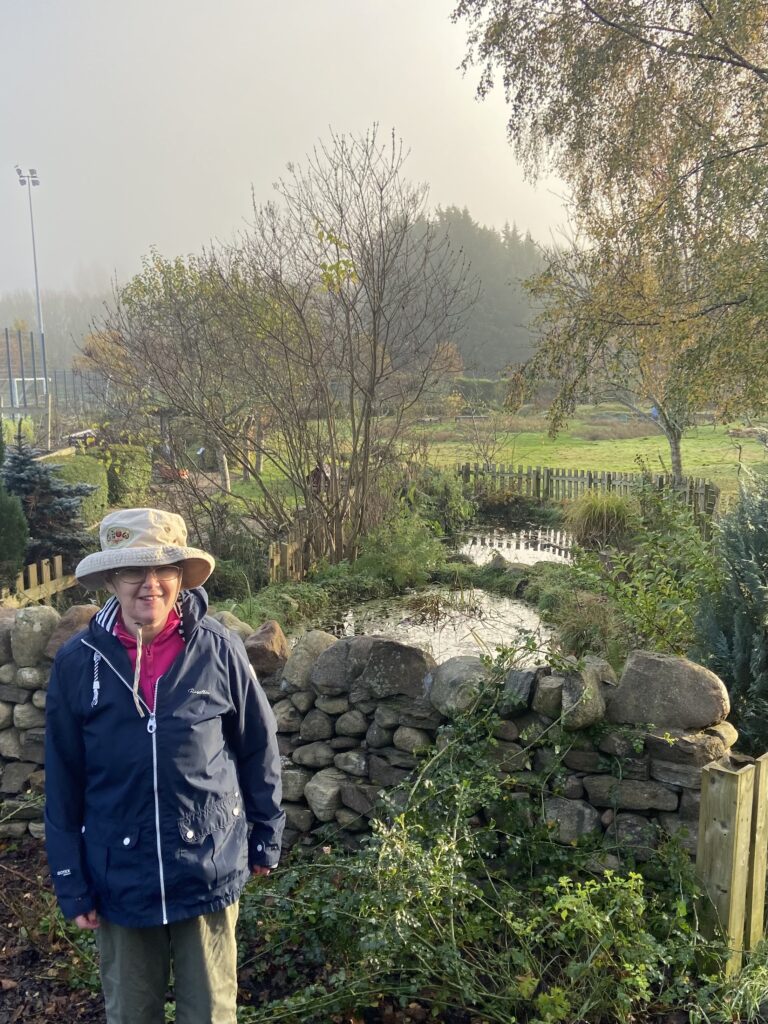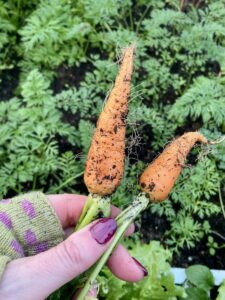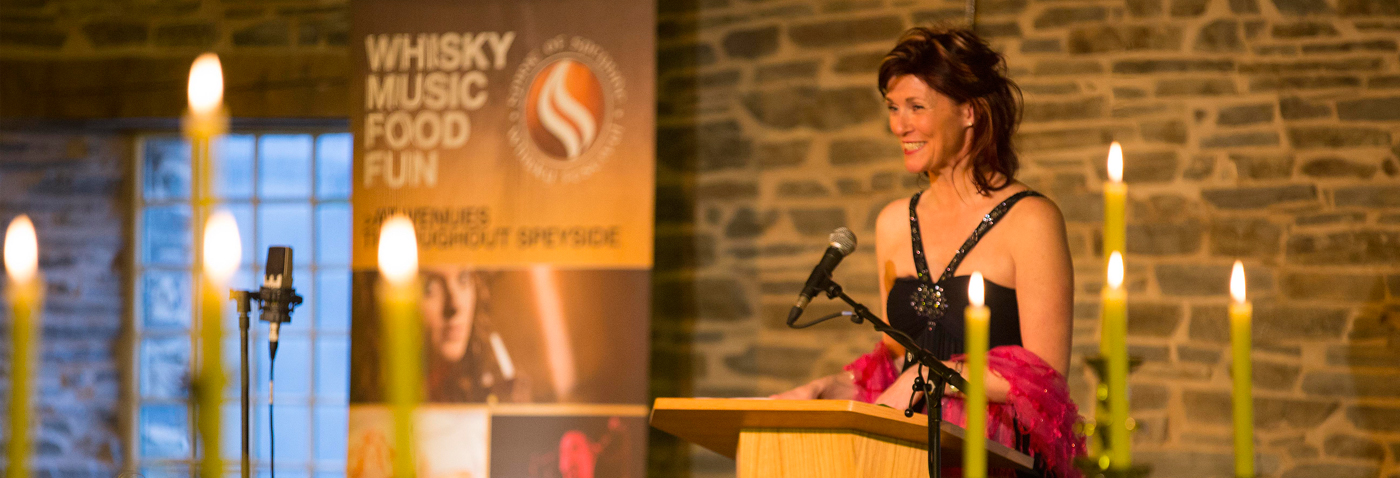That’s it – my garden recycling bin has been filled to bursting for the final time this year, and on Thursday evening I’ll drag it out to be emptied. This final ritual – if past years are anything to go by – is my permission to myself to ignore my garden till Spring.
I will keep an eye out for snowdrop and daffodil bulbs emerging and keep picking the chard, kale, and hardy herbs. I might occasionally sweep snow from the path. Other than that, the garden can hibernate, as will I.
But I can’t say the same for the eager participants of the GROW Project at Inverness’s Botanical Gardens. Their list of tasks, from cutting back overgrown branches, planting, propagating, and potting on, to a final pressing of apples for juice, and the protection of tender plants in greenhouses, poly tunnels and raised beds, continues all year round.
The GROW Project

Grow Project gardeners and volunteers gathering over a well-earned cuppa
I paid them a visit this week, on the coldest day of the winter so far, but left with a warm heart, a belly-full of tea and biscuits, and renewed enthusiasm for getting my hands in the soil even in the depths of winter. This is one special place, as its gardeners and volunteers were all keen to tell me. And, as they’re always on the lookout for more volunteers – not to garden, as such, but to support GROW Project members in the tasks that they undertake – it could soon be part of your life too.
My invitation came from Rona MacFarlane, who, alongside her job-share partner Gavin Skipper, runs the project, which lovingly looks after a huge swathe of land between the Botanic Gardens and the Highland Archive Centre.
Purpose, fresh air, exercise and community
Started over 20 years ago by Jan Ooms, who retired as head of the project last year, but still returns several times a week as a volunteer, GROW, in Jan’s words, ‘gives purpose’ to the adults with learning disabilities who attend every week to develop and care for the garden.

Carol proudly showed me the ponds she had dug, and the wall she had built too. Impressive stuff.
“It gives me purpose, too, as a volunteer,” smiles Jan. But it seemed to me – while project member Robbie announced to us all that England had already scored three goals against Iran in the opening game of the World Cup – that the main benefit of the initiative is the community it creates among the gardeners, the volunteers, and the many visitors to the Botanics.
Jobs are allocated every morning, although preferences are, of course, catered for. Carol showed me round the two ponds she has dug out, lined, and planted, and which now attract abundant wildlife. She also showed me the impressive drystone dyke she helped to build. She enjoys the heavy work, she explained, she likes when her body feels tired after hard work, and she really doesn’t like being helped with heavy lifting.
Experiments, advice, and the reek of wild garlic
From Korean root vegetable mooli, to crocuses grown in the hope of producing the first Highland saffron, there’s a fair whack of experimental gardening that goes on here. Inside the poly tunnel, which is soon to be planted with grapevines, Finlay gave me advice on pruning my chili plants, before wrapping his own in sheep’s fleece to keep them protected throughout the winter.
 I lifted and pocketed a couple of August-sown carrots (delicious after a quick rinse under the tap) and tasted oriental mustard greens, citrussy sorrel and some fronds of fennel.
I lifted and pocketed a couple of August-sown carrots (delicious after a quick rinse under the tap) and tasted oriental mustard greens, citrussy sorrel and some fronds of fennel.
In the propagating shed, Michael and volunteer Aileen, who started with the project after lockdown, had been planting wild garlic, and the air was still heavy with its delicious reek.
Tea time is sacred
The team was beginning to gather for an afternoon cuppa, and amid chat about the football, the biscuits, an upcoming Christmas outing to the bowling, and who had been working on what since lunchtime, there was lots of laughter, and plenty of fresh-air-induced rosy cheeks
Rory whizzed amongst us, tidying dropped plant clippings and mislaid pots as he went. Ewan, who used to be a Project member and is now – after working towards horticultural qualifications – has returned as a Highlife Highland Volunteer, told me he also volunteers at the Green Gym, and for Merkinch Nature Reserve.
The overarching dream is to have project workers ultimately moving into paid roles in the Botanics’ nursery, in the formal gardens themselves, or elsewhere. But that’s still some way off.
For now, it’s about society, purpose, and friendship, boosting confidence and self-esteem, and the creation of a beautiful garden; a resource for us all to enjoy. Priceless.
For more details about the GROW Project, or to volunteer, email inverness.botanics@highlifehighland.com



